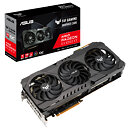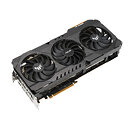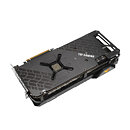- Joined
- Aug 19, 2017
- Messages
- 2,746 (1.01/day)
ASUS has today surprised everyone and decided to launch the first custom design of AMD's Radeon RX 6900 XT graphics card. Previously, the word was that AMD was debating with AIBs whatever to open the GPU to custom designs or keep it AMD PCB exclusive. However, thanks to today's launch, we now know that AMD will allow its partners to design their PCBs and push the Big Navi silicon to its maximum. So when it comes to pushing to maximum, enter the world of ASUS TUF Gaming Radeon RX 6900 XT graphics cards, designed to fit in the line of ASUSes TUF principals.
Featuring a triple fan, triple-slot (2.9 slots more precisely )body, the graphics card is built around Navi 21 XTX GPU. This means that only the best needs to be brought to the card as it is a premium product. That is why the company says that "The TUF GAMING Radeon RX 6900 XT is a tenacious beast with a tough metal exterior, super-efficient cooling, and components that offer enhanced endurance." The built-in cooler offers 0dB cooler technology, meaning that fans will not spin unless the GPU reaches 55 degrees C temperature. The card is powered by two eight-pin connectors, so it seems that power supply requirements are not changed compared to the reference card. While the exact specifications are not known, you can expect the card to boost over the standard 2250 MHz frequency, as it is factory overclocked. Pricing is also not yet confirmed but a slight premium is expected as well.





View at TechPowerUp Main Site
Featuring a triple fan, triple-slot (2.9 slots more precisely )body, the graphics card is built around Navi 21 XTX GPU. This means that only the best needs to be brought to the card as it is a premium product. That is why the company says that "The TUF GAMING Radeon RX 6900 XT is a tenacious beast with a tough metal exterior, super-efficient cooling, and components that offer enhanced endurance." The built-in cooler offers 0dB cooler technology, meaning that fans will not spin unless the GPU reaches 55 degrees C temperature. The card is powered by two eight-pin connectors, so it seems that power supply requirements are not changed compared to the reference card. While the exact specifications are not known, you can expect the card to boost over the standard 2250 MHz frequency, as it is factory overclocked. Pricing is also not yet confirmed but a slight premium is expected as well.





View at TechPowerUp Main Site



